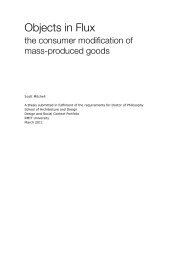Making Memory Space: Recollection and Reconciliation in Post ...
Making Memory Space: Recollection and Reconciliation in Post ...
Making Memory Space: Recollection and Reconciliation in Post ...
You also want an ePaper? Increase the reach of your titles
YUMPU automatically turns print PDFs into web optimized ePapers that Google loves.
facilitates a form of memory practice that imbues a site with significance <strong>in</strong> the collective memory<br />
where none previously existed.<br />
Symbolism <strong>and</strong> built form<br />
The form of this memorial situates itself <strong>in</strong> a tradition of disda<strong>in</strong>ful European memorial practice <strong>in</strong><br />
Africa that disregards <strong>in</strong>digenous memorial practices <strong>in</strong> favour of an imported visual language. Gerard<br />
Moerdyk, the architect, was very conscious of the symbolic potential of its form <strong>and</strong> size <strong>and</strong> sought to<br />
align the Voortrekker Monument with other great monuments: the Taj Mahal, <strong>and</strong> the Egyptian<br />
pyramids. He did so <strong>in</strong> order to situate both his own work <strong>and</strong> the Afrikaner race alongside the great<br />
civilis<strong>in</strong>g forces <strong>in</strong> the world. 117 The deliberate connection between the Voortrekker Monument <strong>and</strong><br />
famous monuments of the past reveals the conscious way that Moerdyk considered the spatial<br />
potential of the monument. The triadic relationship between form, site <strong>and</strong> <strong>in</strong>ternational context<br />
expresses a Heideggerian attitude to the relationship between dwell<strong>in</strong>g <strong>and</strong> architecture. Heidegger<br />
draws an explicit connection between the placement of build<strong>in</strong>gs, their relationship to the earth, <strong>and</strong><br />
their status as architectural constructs. He utilises the example of Greek temples to demonstrate the<br />
significant connection between site <strong>and</strong> built form, imply<strong>in</strong>g that the architecture was almost produced<br />
from the ground itself. 118 This state of be<strong>in</strong>g forms the basis for the nationalistic arguments that follow<br />
(<strong>and</strong> for which Heidegger has been greatly criticised). He presents a notion of identity rooted <strong>in</strong> the<br />
soil, the very essence of which facilitated Afrikaner modes of construct<strong>in</strong>g national belong<strong>in</strong>g. The<br />
assertion that occupation of l<strong>and</strong> is the basis for ownership - a notion upon which colonialism was<br />
based - cont<strong>in</strong>ues to be highly problematic. Jane Jacobs articulates the complexity of such an<br />
assertion <strong>in</strong> a contemporary context, build<strong>in</strong>g upon Edward Said’s notion of ‘geography that struggles’.<br />
She says,<br />
These spatial struggles are not simply about control of territory articulated through the<br />
clear b<strong>in</strong>aries of colonialist constructs. They are formed out of the cohabitation of<br />
variously empowered people <strong>and</strong> the mean<strong>in</strong>gs they ascribed to localities <strong>and</strong> places.<br />
They are constituted from the way <strong>in</strong> which the global <strong>and</strong> the local always already<br />
<strong>in</strong>habit one another. They are the products of the disparate <strong>and</strong> contradictory<br />
geographies of identification produced under modernity. These struggles produce<br />
promiscuous geographies of dwell<strong>in</strong>g <strong>in</strong> place <strong>in</strong> which the categories of Self <strong>and</strong> Other,<br />
here <strong>and</strong> there, past <strong>and</strong> present constantly solicit one another. 119<br />
117 Gerard Moerdyk, Op cit, p.47.<br />
118 Mart<strong>in</strong> Heidegger, Basic Writ<strong>in</strong>gs (San Francisco: Harper Coll<strong>in</strong>s Publishers, 1993.).<br />
119 Jane Jacobs, Edge of Empire: <strong>Post</strong>colonialism <strong>and</strong> the City (London <strong>and</strong> New York: Routledge, 1996), p.5.<br />
40
















